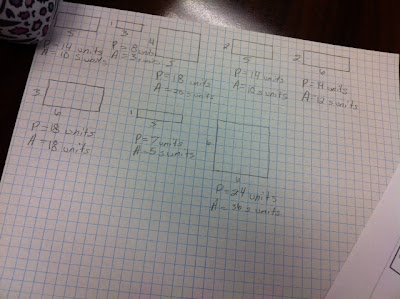The next day, we moved on to finding the area of parallelograms and triangles. This proved to be much more difficult, they concluded. The triangles and parallelograms were drawn on centimeter grid paper, and at first, some students were trying to shade whole squares, then put together pieces to create more wholes. When we shared answers and found that we all had something slightly different, we need we needed a better solution. I asked them why finding the area of a rectangle was so easy for them, but these polygons were so much more difficult. The conversation went something like this:
Student 1: Because with rectangles you just count the squares and that's the area!
Me: Ok.....so why are triangles and parallelograms so much harder?
Student 2: There are sometimes all these little pieces of squares that you have to put together. Sometimes they are easy, like if it's just a half of a square. But other times they are harder.
Me: What is it about rectangles that make it have just whole squares or half squares then? <silence in the room>
Student 3: It....has....right angles?
Me: And....?
Student 3: Right angles are squared off....so they are easier to count!
Me: So what if we made our parallelograms into rectangles so that they are easier to count?
We went on to change each polygon into rectangles and go from there. I let them struggle with this method for homework: not all of the polygons were easy to change accurately. On day 3, we went at it again. Many students came in frustrated and unsure if their answers were correct. And this is how we led into the discovery of the formula for finding the area of triangles and parallelograms!
We began class by looking at a scalene triangle and trying to find its area. I had them do what they did before.....divide it into 2 rectangles and find the area of each, then add them together. This time, however, they had to add up a bunch of half squares and quarter squares. It took them forever and they were frustrated (yet again). After all that, they knew they still had to divide it in half because it was only a triangle. That's when they saw that they were really just finding the area of a rectangle and dividing it in half! We tried this method, which was much simpler to multiply the length by the width, then divide in half, rather then count up all these pieces of squares. I actually had one student's face light up as she yelled out "OhMyGosh! That is SO much easier! Can we ALWAYS do it like that?!" To which I happily replied, "Yes, Ivy, because you just figured out the formula for finding the area of a triangle!" They were so relieved, and shocked, that it was THAT easy. We did a similar discovery lesson with parallelograms, cutting them in half and making them rectangles.
The last 15 minutes of class were spent updating our notebooks and reflecting. We used the right side so show sample problems and made sure to highlight the base and height of each polygon in separate colors to help out our brains. Then, on the left side, I allowed them to write whatever they wanted on area of parallelograms and triangles. They were told they could use words, pictures, examples, formulas, or a combination to reflect on what they had learned. I think they did a great job! They even asked for more time! Here are some examples on the work we've done in our notebooks for area and perimeter:
 |
| Each student received two random arrays. They were asked to find the perimeter of one, use it to define perimeter, and think of examples. Then, we did the same with area of the other. Great visual! |
 |
| Here is the right side of Allison's notebook. They used one color highlighter for base, and one for height to help them see that they come together to form a right angle. |
And lastly, as usual, we always make an anchor chart after we have learned something. Perhaps, if they glance at it enough, the information will stick!!
 |
| Area of Triangles and Parallelograms Anchor Chart |












